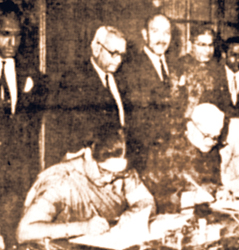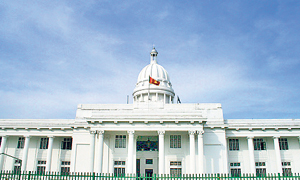A historic agreement was signed on October 30, 1964 in New Delhi by the Prime Ministers of
Sri Lanka and India – Sirimavo Bandaranaike and Lal Bahadur Shastri – to settle a problem which came down from colonial times.
The problem related to the Indian labour population working on estates in Sri Lanka. It revolved round the issue of their citizenship. The pact came to be known as
'Sirima-Shastri pact.'
 |
| Prime Ministers Sirimavo Bandaranaike and Lal Bahadur Shastri sign the historic Pact |
The immigration of Indian labour began as early as the 1830s, when they were brought here to work in coffee plantations. Indian labour was obtained to work on
plantations in several parts of the British Empire. These included West Indies and Mauritius. Being next door, it was very convenient for them to be brought to Sri Lanka and there was a regular flow of Indian labourers in the 1840s. It really became seasonal migration because the time harvesting was over in paddy fields in India, it was time for picking coffee.
The use of Indian labourers became a
permanent feature with the expansion of tea plantations after coffee failed. More and more labourers were brought in and from a seasonal occupation, it gradually became
permanent settlement.
Meanwhile, the British administration ignored the peasant cultivators. Nothing was done to improve their lot. Their land in the hill country was taken over to plant tea. Irrigation tanks were neglected resulting in their inability to obtain water for the cultivations.
As the numbers increased and with
pressure building from the Indian government,
various welfare measures were adopted to improve the working conditions of Indian labour. Free
housing was provided in the form of line rooms in estates, free medical treatment and hospitalization were provided, schools were established and free meals were given to school children.
As the years rolled, the presence of Indian labour in large numbers became a political issue and
several discussions were held between the Indian and Sri Lankan leaders at the highest level to iron out the problem. As early as 1941, Indian Prime Minister Jawaharlal Nehru came to Colombo to have discussions with Prime Minister D. S. Senanayake.
After Independence, when the citizenship of the country was defined, negotiations were initiated with India on repatriation of workers of Indian origin who were not eligible to obtain citizenship.
These were inconclusive and in spite of numerous discussions, successive governments could not find a permanent solution to the problem.
After Mrs. Bandaranaike came to power in July 1960 and consolidated relationship with India, agreement was reached with Indian Prime Minister Shastri for the repatriation to India of 525,000 persons of Indian origin and the granting of Sri Lanka citizenship to 300,000 persons.
CMC celebrates Centenary
Centenary celebrations of the Colombo Municipal Council (CMC), the country's premier local body were held on October 28, 1965.
After the formal approval of the Ordinance by the Legislative Council to set up a Municipal Council for the City, the limits of the Council were fixed by a Proclamation dated November 24, 1865.
Three days in mid-January 1866, saw election meetings being held in different parts of the City. The
inclusion of elected
members was considered a bold innovation at a time when even the Legislative Council did not have a
single elected member.
The first meeting of the Council was held on January 16, 1866, In addition to the nine elected
members, five were nominated by the Governor. They included
C. P. Layard, Government Agent – Western Province who served as Chairman. Until 1877, the Government Agent was the Chairman. (Chairman later became Mayor).
The first elected Mayor was
Dr. R. Saravanamuttu (May 1937). The Mayor in the Centenary Year was M. Vincent Perera who later became a Member of Parliament and was Minister of Sports.
Among the Mayors were A. E. Goonesinghe, George R. de Silva, R. A. de Mel, R. F. S. de Mel,
Dr. Kumaran Ratnam, Dr. N. M. Perera, V. A. Sugathadasa and
M. H. Mohamed.
With the increase in population, the number of wards steadily increased and there were 47 wards in the Centenary Year.
|


